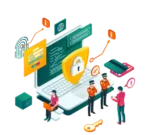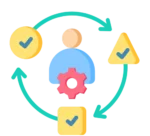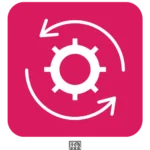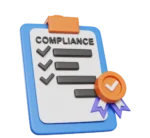Cyber Security Software
Stay ahead of threats with robust cybersecurity software
Talk to our cyber security experts…
Stay ahead of threats with robust cybersecurity software
Talk to our cyber security experts…
Cybersecurity software delivered as a service (SaaS) provides businesses with cloud-based protection against digital threats, allowing companies to access sophisticated security tools without extensive on-site infrastructure.
By subscribing to a SaaS cybersecurity service, businesses benefit from real-time updates and threat intelligence managed by experts, ensuring robust defence mechanisms against evolving cyber threats.
This service model reduces the complexity and cost of traditional cybersecurity setups and can scale with business growth or adapt based on seasonal variations.
While not an entirely new service, recent improvements to global connectivity through satellite and 5G broadband, robust dedicated line broadband, and AI and machine-learning algorithms have improved these cloud-based cybersecurity services.
Before delving into the reasons why cybersecurity SaaS is so revolutionary, see this list of the best-known solutions to get familiarity with their names and features:
| Provider | Key Features |
|---|---|
| Qualys | Market leader. Offers comprehensive vulnerability management, compliance, and web application security. |
| CrowdStrike | Specialises in endpoint security, threat intelligence, and incident response. |
| Palo Alto Networks | Provides a wide range of security solutions, including firewalls, endpoint protection, and cloud security. |
| Darktrace | Utilises AI for real-time threat detection and autonomous response across networks and digital systems. |
| Okta | Focuses on identity and access management, providing user authentication and data access control. |
| Zscaler | Offers cloud security, securing user data and applications through encrypted access. |
| Tenable | Known for its vulnerability scanning and network monitoring capabilities. |
| Symantec (Broadcom) | Provides a broad suite of security products, including malware protection and data loss prevention. |
Cybersecurity software-as-a-service (SaaS) offers:

Detects threats faster and more effectively than static, rule-based systems. It’s also set-and-forget; your SaaS will take care of its maintenance.

Offers continuous monitoring and protection. It will respond immediately to threats and alert your IT staff.

Maintains compliance with current cybersecurity regulations, avoiding the risks of outdated software.

Scales with your business, eliminating the need for frequent manual system updates or expensive on-site visits.
Cybersecurity software solutions provide a comprehensive and adaptable business defence mechanism, combining advanced technology with user-friendly features.
These platforms offer a range of security measures tailored to protect various aspects of IT infrastructure, detect and respond to threats in real time, and ensure compliance with regulatory standards.
With the ability to seamlessly integrate with existing systems and scale according to business growth, these solutions are not just protective measures but strategic business tools.
Here’s a table summarising the key features of cybersecurity SaaS:
| Feature | Description |
|---|---|
| Comprehensive Security | Includes endpoint protection, network security, and cloud security to safeguard all aspects of IT infrastructure. |
| Real-Time Threat Detection | Utilises advanced algorithms to detect threats as they occur, ensuring immediate identification. |
| Automated Response | Automatically counteracts detected threats to minimise damage without manual intervention. |
| Scalability | Adjusts capacity as business needs grow without requiring additional physical infrastructure. |
| Integration Capabilities | Easily integrates with existing IT setups, enhancing current systems with improved security features. |
| User-Friendly Interface | Designed for ease of use with intuitive controls, making complex security operations manageable for all users. |
| Regulatory Compliance | Helps businesses meet specific industry regulations such as GDPR, enhancing data protection and privacy standards. |
Cybersecurity software is a powerful innovation that is disrupting the traditional cybersecurity space. However, its cloud-based approach brings some inherent challenges.
Here is a summary of the pros and cons of cybersecurity SaaS:
Here’s a table summarising the main benefits:
| Advantage | Description |
|---|---|
| Enhanced Security | Provides robust defences against various cyber threats, including malware and phishing attacks. |
| Compliance Assurance | Helps organisations comply with legal and regulatory requirements, reducing legal risks. |
| Real-Time Monitoring and Response | Continuously scans and reacts to threats, minimising potential damage quickly and efficiently. |
| Cost Efficiency | Reduces the need for extensive in-house security teams and can lower overall security management costs. |
Cybersecurity software inherits the drawbacks of relying on automated tools like AI and cannot solve on-site problems, which a customised solution can also protect against.
| Disadvantage | Description |
|---|---|
| Complexity | It can be complex to configure and manage, requiring specialised knowledge or training. |
| False Positives | May generate false alarms, leading to unnecessary investigations and resource allocation. |
| Dependence on Updates | Effectiveness depends on regular updates; outdated systems may become vulnerable to new threats. |
| Potential for Overreliance | May lead to complacency, with users assuming software alone is enough to guarantee security. |
| Not comprehensive | It cannot cover site-specific security, such as insufficient network security, outdated software and systems, poor security practices, social engineering, physical hardware theft or damage, or internal data leaks. |
Cloud-based cybersecurity software-as-a-service (SaaS) is operated 100% remotely through a secure internet connection, offering ongoing, real-time protection against cyber threats.
Here’s a simplified step-by-step explanation of the typical process flow followed by cybersecurity SaaS upon encountering a threat on a client’s systems.

The system continuously scans for anomalies and potential threats using advanced algorithms.

When a threat is identified, the system immediately alerts the security team and logs the threat for review.

The software analyses the threat’s characteristics and potential impact.

After a threat resolution, the incident is documented to enhance the system’s predictive capabilities. Essentially, the algorithms are constantly learning.

The team of cybersecurity experts overseeing the product are constantly monitoring regulations and other vulnerability to ensure the software is also updated by humans.
Here’s an overview of the typical technical specs of cybersecurity software, bearing in mind that the idea is to avoid extensive internal infrastructure.
Note that each software provider specialises in its niche and has a slightly different tech stack to differentiate itself from competitors.

Operates on a secure, scalable cloud platform, minimising the need for local hardware.

Real-time data processing to detect threats as they occur.

Machine learning techniques and AI adapt and improve detection strategies over time.

Incorporates high-grade encryption to secure data in transit and at rest.

Ensures compliance with relevant regulations (e.g., GDPR, HIPAA) through up-to-date protocols.
Several British institutions have prevented cybersecurity breaches by implementing security using a SaaS model. Here are three notable examples:
The University of Chichester enhanced its cybersecurity by adopting Mimecast‘s email protection tools while transitioning to online learning triggered by the pandemic.
This fully remote implementation fortified their VoIP system and email security without requiring expensive on-site visits. It ensured safer outgoing communications and fewer spam issues, and the university IT staff reported that it lightened their workload, allowing them to focus more on strategic tasks rather than just reactive measures.
This case exemplifies a successful application of cybersecurity SaaS, demonstrating Mimecast’s ability to scale with the university’s needs and improve its overall cyber resilience.
The British Heart Foundation (BHF) implemented its online payment capabilities to remain competitive with e-commerce retail and adopted Qualys Express for automated vulnerability management and compliance.
BHF conducts regular, automated scans across its retail and corporate networks, identifying and addressing vulnerabilities to enhance security. So far, using these tools has avoided major breaches.
Additionally, online payments require maintaining compliance with the Payment Card Industry Data Security Standard (PCI DSS), and Qualys has enabled to do this without requiring human resources from BHF.
Addison is a leading UK engineering firm that recently bolstered its cybersecurity by adopting Darktrace’s AI-driven solutions.
Addison integrated Darktrace to oversee network, email, software, and web app security, recognising the need to effectively protect clients’ sensitive data, with their principal motivation to maintain and build client trust.
💡 Engineering firms now regularly use smart devices in their implementations, which requires dealing with extensive and often sensitive user data.
The firm particularly values Darktrace’s autonomous response capabilities, which drastically reduce the time and effort needed to address threats, streamline security processes, and ensure 24/7 protection.
This integration has positioned Addison as one of the leading engineering firms when it comes to securing their client’s data, recognising that business cybersecurity is essential in an increasingly digital world.
Our business broadband experts answer commonly asked questions on cybersecurity software.
Cybersecurity software-as-a-service protects against all common cybersecurity threats, such as Malware, Phishing, DDoS Attacks, Zero-day Exploits, Insiders, and Advanced Persistent Threats.
However, it cannot fully cover site-specific security, such as securing networks with bespoke business broadband routers, keeping core software and systems updated, fixing poor security practices, social engineering, physical hardware theft or damage, or internal data leaks.
Cybersecurity SaaS is renowned for its immediate response, relying on real-time monitoring, immediate alerts and automated responses.
This is especially true for advanced systems with machine learning capabilities that can detect and respond faster by learning from previous incidents to anticipate and neutralise threats more swiftly.
The faster the business broadband speeds, the quicker it will respond.
Cybersecurity SaaS providers typically offer comprehensive support services to ensure clients can effectively manage and respond to security threats. Key support offerings include:
| Support Type | Description |
|---|---|
| 24/7 Monitoring | Continuous monitoring of networks and systems to detect and respond to threats around the clock. |
| Customer Service | Access to help desks and customer support teams for troubleshooting and issue resolution. |
| Incident Response Assistance | Expert guidance and support for handling and mitigating cybersecurity incidents. |
| Regular Updates | Frequent software updates to incorporate the latest security patches and threat definitions. |
| Training and Education | Educational resources and training to help users understand security best practices and software use. |
| Compliance Guidance | Support in meeting relevant compliance regulations and maintaining standards. |
Implementing cybersecurity software typically involves several key steps to ensure it integrates well with existing systems and offers optimal protection:
| Step | Implementation Step | Description |
|---|---|---|
| 1 | Assessment | Evaluate current security needs and posture. |
| 2 | Selection | Choose software that fits organisational requirements. |
| 3 | Configuration | Customise settings to match policies and risk tolerance. |
| 4 | Installation | Install the software across necessary systems. |
| 5 | Integration | Seamlessly integrate with existing IT infrastructure. |
| 6 | Training | Educate users and IT staff on effective software use. |
| 7 | Testing | Test software to ensure proper threat detection. |
| 8 | Monitoring and Maintenance | Continuously monitor and update to combat new threats. |
Yes, broadband performance can impact the effectiveness of cybersecurity, as faster and more reliable internet connections improve the speed and efficiency of security updates, monitoring, and response actions.
This is why choosing the right business broadband provider and the correct technology is important. In the UK, the following is on offer:
Here are the best tethered technologies in ascending order (least to most performant):
Here are the best wireless technologies in ascending order (least to most performant):
Consider using our business broadband comparison service to find the best deals for your business premises.
It’s important to consider the IT security requirements of your business. A basic business broadband package may not provide the security levels your business requires.
Here are the three important security factors if you’re considering looking at a cheap business broadband deal: